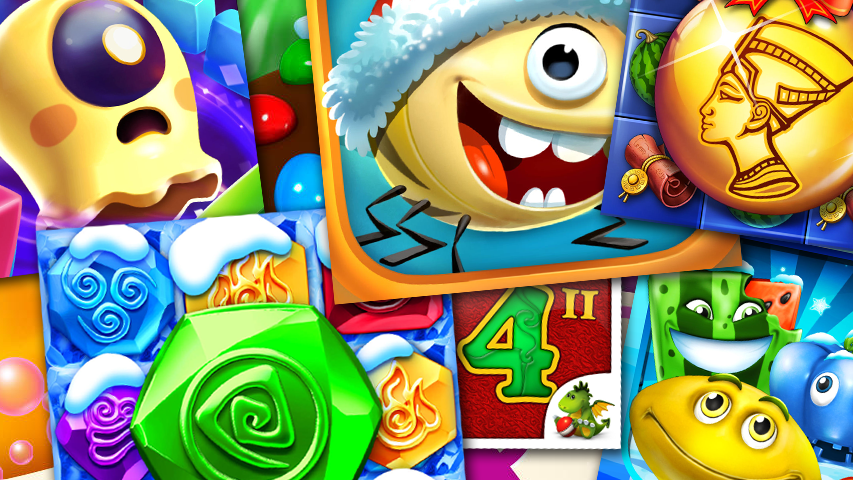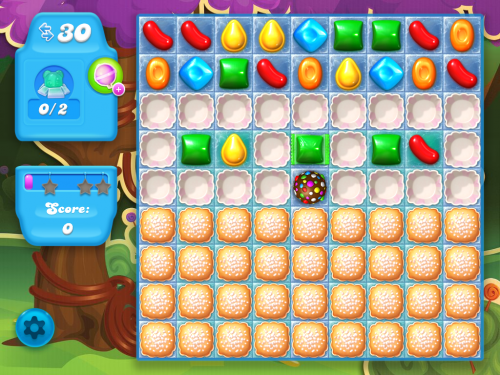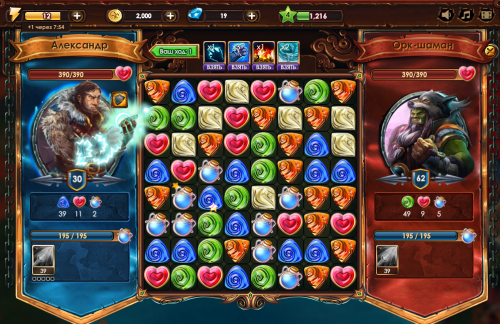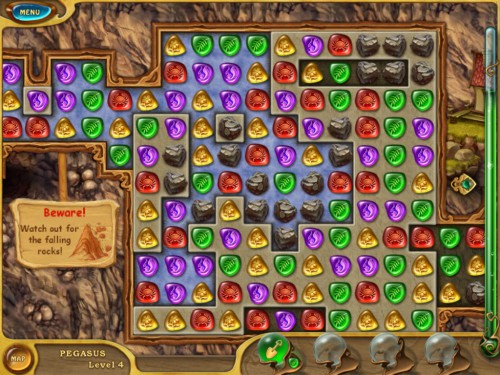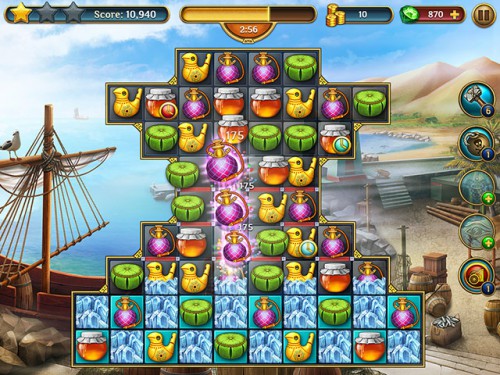Match-3 Development Secrets: interviews with Awem, Nevosoft, Nika, Playrix and Renatus
Awem, Nevosoft, Nika Entertainment, Playrix and Renatus companies told App2Top.ru about the secrets of game development in the “three-in-a-row" genre.
Our questions were answered:
- Oleg Rogovenko, producer of Awem
- Roman Ignatovich, Chief Programmer at the Samotsveto V Planet project, Nevosoft
- Viktor Trukhnov, General Product Manager, Nika Entertainment
- Vladimir Minin, Director of Production, Playrix
- Denis Presnov, producer of Renatus
I'll start with a basic question. I really like the latest Candy Crush Soda Saga, but when playing, I can't help feeling that this is the most real slot that pretends to be match-3. Hence the question: how much in match-3 should depend on the player, and how much on luck?
Oleg Rogovenko
Awem: It depends on which audience you want to reach. If we are talking about women 35+, then 60% should be given to luck, 40% to skill.
Any match-3 level at the start should give the player the feeling that if they are lucky, the player will pass it for free. This should happen periodically, otherwise the player will lose this feeling, and with it the interest in the game.
As you progress through the game, the difficulty of the levels increases and, accordingly, the probability of passing for free the first time decreases. But at the same time, I repeat, at the beginning each level should look passable. And the player should retain this feeling for almost the entire level. At the end of the level, if unlucky, the player makes a choice: replay, or, if you want to accelerate and move to a new level, pay (buy moves, bonuses, etc.).
Roman Ignatovich
Nevosoft: It depends a lot on what you want from a player at a particular level. If you want to let the player relax, then the level should not depend on luck, the skill will just help you score some incredible score. If you want to make him think and, moreover, pay, then you need to collect the level so that only luck and patience will help him pass it. Another thing is what a particular player likes: a skill player wants a bunch of difficult levels, and if a person just wants to move the chips, then you need to let him do it. Everyone should be happy if possible.
Victor Trukhnov
Nika Entertainment: Let's just say luck in the game is an accurate calculation. It all depends on mathematics, on the balance of the game, which adapts to the player's actions and passes him further through a certain number of fail levels. At the same time, the user should feel that everything depends on him and the only chance that separates him from winning on the last move, seconds of the level (if he is playing for time).
If the system is calculated and works well, the algorithm skips the player to the next level, and this is perceived by them as luck. If the algorithm is poorly constructed, the user is likely to notice it after a few games. And he will definitely feel shortchanged by the system. This should absolutely not be allowed!
In our games, we use different, but always precisely constructed algorithms, which allow us to talk about the uniqueness of the balance of our products as a whole.
Vladimir Minin
Playrix: In my opinion, the player's success should depend on luck as much as possible. The share of luck should not be higher than the level after which the player loses the feeling that his actions really affect the outcome of the game. But, at the same time, it should be above the level when the player retains the hope until the last move that now he will be lucky by chance, the necessary chips will fall out, and he will be able, even by a miracle, to pass the level. The task of game designers is to find this delicate balance.
Denis Presnov
Renatus: In any skill game, the player must have a feeling that the final result depends on his efforts. Match-3 games are no exception. For this reason, the so—called “skilled” players should feel like a fish in water, but the luck factor is a strong incentive for beginners, which means the game should be balanced so that both the beginner and the seasoned player are interested in playing, and the result depends only on which player is playing it.
And how important is this point in general? Isn't the main thing in match-3 not the ability to mindlessly snap pebbles? You know, there's a packaging film with bubbles that everyone likes to pop so much. So the main thing here is the process, no?
Awem: Everything is important in the game – both the process and the purpose of this process. It is important that they do not contradict each other, and give each player what he needs. Even the same player wants a meaningless but enjoyable process today, and tomorrow he will have a different mood and he will think: "And for what purpose am I doing all this?"
Nevosoft: It seems to me that with the current model (as in Soda Saga), this is not entirely fair. It is important how much you have gone through, and the feelings after this process. It is very difficult to single out one thing. The “process” forces you to play on. But the players think about the number of completed levels and are measured by this indicator.
Candy Crush Soda Sada (King)
Nika Entertainment: In our games, we try to get a person to not just pass the levels. The main thing is the flow that we create. We put the player in a state where the game fascinates and "drags" him so much that he goes through 30 or 40 levels in one session. And, most importantly, he does it with great pleasure. Some players get new impressions and joy from the game due to the constant updating of content — the appearance of new locations, etc. They just want to complete the levels, and it doesn't really matter how they do it. For the second, it is extremely important to get a high-quality puzzle, the opportunity to puzzle over one or another condition. Still others just came to play another match-3, but discovered something new for themselves. In any case, our task as a developer is to provide all people with what they expect from the game.
Playrix: It seems to me, unlike bubble wrap, match-3 is always a very gambling game. The presence of a randomness factor in match-3 is a key point. It doesn't matter if the player wants to mindlessly click the pebbles, or if he feels like a master and wants to play very intently in order to score more points than friends. It is important that in both cases, the presence of the luck factor and a huge number of options for the development of the game situation will be able to pick up and keep the player's interest.
Renatus: Of course, the main thing is the process, but modern games are not only the “clicking” of pebbles, they are also socially competitive elements and a certain personal challenge, so it is important that the game can provide the player with these emotions and experiences. You're not interested in just clicking pebbles, right, but clicking pebbles for some purpose is already much more exciting, and if, after completing this goal, you also beat a friend, then you generally take pride in this micro-victory.
Continuing the topic: and what, in general, in the gameplay of match-3, in your opinion, is the most important thing, what is the key thing without which collecting pebbles will be boring and uninteresting?
Awem: In this sense, nothing has changed in the last 10 years. All the same bearded components work:
- as long as possible — a "live" learning curve (ideally, the whole game);
- a balance of difficulty, perfect for the target audience (you need the right file and a lot of patience);
- The z-axis of interest is well integrated with match-3 levels (a long map with portraits of friends in king games is a good example).
Nevosoft: I would say intrigue and visual design.
If you just move something somewhere, then there will be no intrigue, you need to have the usual path to complete the level (i.e. counting only on luck), and a strategy in which the level can definitely be passed.
Colorful effects are a visual facade for the levels, victory is made even more enchanting, and defeat is not so offensive: "although I saw a beautiful effect, well, cool."
Nika Entertainment: The main components of a successful game are fan, milling and proper distribution of player's successes and failures. Without this combination, the project turns into a boring compilation of combinations of pebbles.
Crystal Lords (Nika Entertainment)
As I said in a previous interview, victory must be interspersed with defeat in order for vivid emotions to arise. The game is an emotional experience. First, you need to engage the user with interesting content and motivate them with success. The game should not seem difficult from the very beginning, so that the player gets used to it and just enjoys the process. When he is fully involved, it is worth alternating simple levels with complex ones. After several losses, when the user is almost desperate to complete the level, it is extremely important to let the person win.
Playrix: If we talk directly about the mechanics of the match-3 game itself, then, probably, the presence of just this variability in the development of the game situation on the field. That is, the more space in the game in which the player's luck can manifest itself, and the more complex and interconnected this space is, the better. The deeper the connection between the basic mechanics, bonuses, and game elements on the field, and the richer each of these components is in itself, the more multifaceted the luck factor can manifest itself, and the more interesting the game will be for the player.
If we talk about the game as a product in which, in addition to the main game mechanics, there is also some kind of binding around match-3, then it is difficult to answer unequivocally. The key feature influencing the success of the game, in addition to, in fact, the mechanics of match-3, can be a unique and interesting meta-game, or some interesting interpretation and presentation of match-3 mechanics, or a unique atmosphere of the game world, etc. In any case, no matter which part of the game you want to make the key, you need to try to make this part really innovative and highlight your game on the market.
Renatus: I think that it is impossible to single out the only important parameter in the gameplay of match-3. Someone likes to calculate everything in advance and, like a chess player, make the right moves to win, someone likes a chain reaction when a chain of 3-4 or more combinations burns down from one move, and someone just plays to show off to friends. The issue is complex, I would say.
You've probably come across when playing some match-3 games (this is especially common in the already mentioned Candy Crush Soda, but there is this, for example, in Best Fiends) that the level is played a step or two away from victory. Just when it seems to you that the fireworks are about to start, the game informs you that the moves are over and you need to pay. There is a general definition for this — a good balance, but I am primarily interested in the method here.
Best Fiends (Seriosly)
As I understand it, conditionally this is a formula that calculates how many combinations there should be before each throwing of new chips on the field. And as we approach the final level, the number of combinations decreases, and the probability of losing combinations itself is endowed with a percentage. For example, if the user has scored half of the points necessary to complete the level, the number of combinations allowed on the field is reduced from five to three (they fall out with 100% probability), but if 1/3 of the points acquired are left to the first star, then the number of combinations is reduced to two (and the one that will bring the highest number of points is 10%). So, do you have this in games, and if so, can you share similar principles?
Awem: We don't have this in games, and so far we don't see much point in such "maneuvers". Try to complete any level 10 times (except the first 24, which are relatively easy) in our Cradle Of Empires. You will have a different result each time. This is a natural property of a normal match-3 level, with an ordinary, honest randomizer. And it is quite enough for us to monetize those who are unlucky and who want to skip the level as quickly as possible and move on to the next one. As for the various smart mechanisms, I think if the paying player feels that he is being manipulated, he will leave. Those who want and are used to paying will sooner or later be monetized if the game is good and the balance and paywalls are correctly built in it.
Nevosoft: It's good enough to balance the level, make a bunch of iterations on different players (power players and those who are not familiar with the genre at all or are poorly familiar) + pay attention to the reaction of users after launch, both in terms of stats and reviews. Specifically, in the "Planet of Gems" we do not have any rigid algorithm for generating a field, but in general, the mechanics are laid down so that luck affects at a minimum.
Nika Entertainment: I can say that our algorithm in its early stages was extremely similar to what you described and was extremely clumsy. For example, if there is only one condition for collecting a complex element in a level task, then the algorithm stops. Of course, I have no right to reveal all the secrets, but ... an important step to improve the algorithm was the involvement of an outside specialist. A fairly intelligent mathematician with experience in slot projects laid out the algorithm for us on the shelves and showed us where to avoid sagging, at which points. We have added a dozen events to the current algorithm, which help to correct the situation. In addition, we take into account previous experience, the quality of the current session and the overall game progress.
The main rule for us is not to rate games as “black boxes”. Any game or mechanics for us is an analysis. Only on the basis of clear numbers and dependencies will you be able to improve each new product.
Playrix: In our games, we do not use algorithms that somehow manipulate the chips that fall on the field. The chips always fall out randomly. We are trying to balance the levels due to the configuration and settings of the level itself. And personally, as a player, I have never felt that such algorithms exist in some top match-3 free-to-play projects. It seems to me that in most games, it is just a random algorithm that is used to drop chips.
4 Elements II (Playrix)
Renatus: Yes, of course, modern match-3 games are very fond of “pissing off” the player, creating a strong desire for him to pay when he is about to pass the level. Unfortunately, I cannot reveal how this works with us; I can only say that there are many approaches, except for what you have announced, to the point that for each level, developers have generated arrays of game elements with different difficulty of passing, which is determined by multiple split tests and measuring statistical data from each of course, but this is one of the most clumsy methods.
There are enough types of gameplay in modern match-3. There are "bring the chip across the field", "smash all the stones", "score such and such a sum of points" and so on. I would like to know which modes, in your opinion, are the most popular. Ideally, if you make the top 5 most popular level types among your players.
Awem: So far we are using only one passing mechanic — "smash all the stones in the allotted amount of time/moves". Plus, there are several modifications of it: night, skulls, colorless chips, etc. Plus, there are a dozen different types of obstacles that are smoothly introduced into the game, and then combined with each other. And all this turned out to be not enough. We plan to gradually introduce new mechanics and obstacles.
We do not consider any one mode as the most popular. They work in a complex. Simply put, after a couple of levels with a "favorite" mode, the player gets one slightly "unloved" one. This approach, in moderate doses, gives the gameplay an emotional dynamic, which, in turn, forms an attachment to the game.
Nevosoft: The most popular one is to take everything off the field by simply moving the chips, i.e. the levels on the rush are usually based on the "remove the cage" mechanics. One can only assume further. People like familiar mechanics (hold a chip down the field, score points). Something new sometimes scares you away.
Planet of Gems (Nevosoft)
Features in mechanics should not only strain (bear a negative imprint, such as "if you don't remove the chip in time, you lose the level"), you also need a dose of positivity ("for example, a chip that matches everything"). I.e., the player goes through colorful levels with a bunch of explosions that are simpler than the main mass and just gets high. If deliberately difficult levels are diluted with positivity, the audience eventually remains more satisfied.
Nika Entertainment: In short, it doesn't matter what types of levels are used, the main thing is their variety and the right balance, as well as understanding that the game needs to be treated as a service. That is, to give the players the experience they came for.
And the correctness of the conclusions about consumer expectations can always be checked on playtests and in the statistics of the soft launcher:)
Playrix: Our main match-3 free-to-play projects are still under development and we do not have any representative statistics specifically for our games. But it's easy to make such a top if you look at successful match-3 games in the App Store. I think I won't be much mistaken if I say that the most popular modes are those for removing colored cells from the field and for completing orders to collect certain elements from the field (collect 3 blue and 5 red chips, for example). And various variations of these modes.
Renatus: There are many different trends in gameplay types right now. If I were to rank the popularity of the basic types of gameplay that are present in almost every match-3, I would arrange them in the following order:
- Collect the nth number of elements (30 red, 25 blue, etc.);
- Collect the nth number of points;
- Break all the blockers;
- Bring the chip across the field;
- Collect the nth number of combinations.
It is worth noting that many new games, as I see them, add or modify old types, thereby introducing novelty and captivating users with new and interesting goals to the level.
The server side is one of the most important components in mobile games today, but at the same time it is often one of the most expensive and complex. How critical is it for match-3 today? These are usually single projects, why do they need servers, except for leaderboards?
Awem: So far, we need the server only for technical purposes: collecting statistics, remotely editing the balance, synchronizing the player profile between several devices, etc.
Cradle of Empires (Awem)
Nevosoft: It seems to me that this is just a general, reasonable trend in the development of the industry. Take, for example, saving and synchronizing player progress between devices. There are more or less suitable options from the platforms themselves (iCloud, for example). However, you want to be able to save user data, as well as receive it, both from iPhone, Android, and Windows Phone, and if there is a social version of the game…
You can get hold of one solution on your own or someone else's server and sleep peacefully, or implement 20 branches of functionality and spend all your time, money and nerves on porting, and, as a result, you will not get the proper result. Your own server gives you more flexibility, a ready—made solution, such as Parse, - no need for support. Servers allow you to bring social interaction in the game to a higher level, send gifts, make calls or just chat. The last point is user support. If there is no server, then there is no way to help the player if something went wrong.
Nika Entertainment: A reliable server part is also needed in order to counter the market of rooted devices on iOS and Android, on which cases of piracy are not uncommon. And, accordingly, in order not to lose part of the income on this.
The server part helps to protect the game balance and game logic from hackers. Our technical specialists helped to develop a system that provides multi–level user protection, and is able to secure both consumer purchases and the results of the levels passed by players so that they cannot be replaced.
Another important point is that we have introduced full synchronization, which requires a server solution. It is very important to give users the opportunity to play cross—platform games - both in the office and in the subway.
Playrix: Indeed, the match-3 genre is probably one of the least demanding server—side genres among all free-to-play games. If we talk about the mobile version of the game, then the server is needed to store player profiles, to store levels, and to store statistics. Most companies are now launching a version of the game on Facebook at the same time as launching mobile versions of the game. In this case, the requirements for the server side increase significantly, since it becomes necessary to store on their servers not only profiles, levels and statistics, but also the game itself (code, resources). But, in any case, the issue with the server part for the match-3 game is definitely not critical. Moreover, you do not need to do anything yourself, since there are many ready-made solutions from third-party companies.
Renatus: Of course, PvP games usually have high server costs, where a lot of miscalculations are required on the interaction of players with each other, but do not underestimate single-player projects. The server side of such projects is like an invisible underwater part of an iceberg. For mobile games, it can include a multiplatform account system, leaderboards, a notification system (both in-game and external), and an anti-fraud system.
Bubble Chronicles: Epic Travel (Renatus)
And since we are already talking about leaderboards, what types of, let's say, "asynchronous competitions" best affect the retention / return of users to the project? In other words, how do the portraits on the map significantly stimulate the players, and how do the tops at the end of each level?
Awem: If we focus on the traditional segment of casual players in which we work (women 35+), then for them, in terms of social functions, it is not so much competition that is important, as a sense of belonging. Seeing portraits of friends in the game + the ability to swap utilities is one of the pleasant features in the game, but it is not key for 2/3 of our players. This is the specifics of our target audience specifically. Trying to tie the gameplay more tightly to friends is a risk of alienating a significant part of the audience, which has few or no Facebook friends playing. What is good for King is not the fact that it will work for other companies. Everything is individual and strongly depends on your main traffic sources.
Nevosoft: It depends on the project. It is in match-3 that the icons of friends on the map mean little, except just to tease a neighbor (and then if he notices it). People add friends to get a free gift, rather than paying a blood ruble for the opportunity to play 1 more level. It seems to me that leaderboards are more effective when it comes to player retention, everything is simple and clear there: "This person is 100 times better than you at playing match-3."
Nika Entertainment: A simple top at the end of the level does not stimulate the players much. On one of the AB tests, we checked this issue - the discrepancy is a couple of percent both in terms of retention, replayability, and the viral channel of this top.
But I can say that the field for experimentation is huge here. We have recently gained a unique experience. We introduced a separate bonus location, which was based on the tournament principle, and also created a common top for the entire player server. At the same time, the lives were completely removed.
Our task was to re-engineer the players as much as possible, keep them, and prevent them from switching to another product if they ran out of lives in our game.
The metrics showed that we hit the nail on the head in this regard. We have almost doubled the average session duration, increased retention, etc.
And one more important point: in order to maintain the balance of the game, we made the prizes for the top small and, unlike other games, we practically moved away from using premium currency as a re-payment. We gave it as a reward only to the top 5 players of the server. First of all, in order to motivate users to take prizes and invest money in the fight for the championship in the tournament.
Playrix: Again, while we don't have our own statistics, I can't say for sure which of these elements works better. But there are fairly standard solutions present in all successful games, so it is obvious that both the leaderboards after the level and the avatars of friends on the map clearly work very well. And it is also obvious that both of these features are mandatory for implementation in any free-to-play match-3 project. And, of course, the main thing here, as everywhere else, lies in the details. It is important to think about the correct presentation of these features, the correct presentation of information about, for example, that your friend beat you in points at some level, or passed more levels in the game than you did.
Spooky Pop (Supercell)
Renatus: Each type of competition is aimed at its own group of players, so, again, it is difficult to compare them. For example, the tops at the end of each level are aimed at increasing the retention of the first and third days, as they involve the player in the competition here and now. In other words, the player, seeing that his friend is playing the game, wants to try to get around him in an accessible plane, namely at the level. And the portraits of friends on the map are designed to retain already “established” players who will already compete with each other — in addition to who will score more at the level, so also who will go further
Recently, we published an article about the types of cards, and, to be honest, it was not very warmly received, because, they say, it only described the general points. That's why I wanted to return to this topic, to ask what type of cards you like and why. That is, what is better, to throw the player on a huge map, or to give one small card with each pack, perhaps in some other way to work with users in terms of submitting levels?
Awem: The main thing is not to give an unprepared player too many alternatives. In Cradle Of Empires, the map is slightly larger than the iPad screen, but there are many different houses with levels on it. In order not to confuse the player at the start, I had to remove half of the map into the fog, which gradually opens up new areas during the game.
Nevosoft: It seems to me that both options have advantages. When everything is visible (a huge map), it's cool, you feel your progress, there are so many levels passed, you don't have enough eyes, but since the map is large, you need a zoom, extra movements to just start the level. When the map is divided into packs, it becomes possible to display more diverse content, the level buttons are large and convenient, but moving from the last pack to the first is a disaster.
Nika Entertainment: It's hard to give one cool recipe here. My personal opinion is that the atmosphere is very important for the map. Therefore, I consider the ideal card to be one that gives the player the feeling that he is walking through the endless world of the game and is constantly waiting for something to happen. The passage of such a map causes a certain immersion in the setting.
It is this "infinity" of the game that we want to give to the users of our new Unity projects.
Playrix: The article about the types of maps published on your portal seemed very useful to me, because it summarizes the game design experience and gives the reader a ready-made set of tools for implementing the map in their game. At the same time, the article does not give unambiguous recommendations about choosing a card, because there can be no unambiguous answer here. It all depends on the setting of the game, the presence/absence of a meta-game on the map, and other factors.
For example, there is Jelly Splash with a very concise and exaggerated game world. And the map in this game is appropriate. And there is Gummy Drop, where it is assumed that the player travels through the real world. And he doesn't just travel, but builds different buildings and performs tasks from various characters on the map. Accordingly, the map in this game is atmospheric, detailed, scrollable and zoomable. How the map will be implemented in your game is up to you, there are no ready—made recipes.
Renatus: In my opinion, the presentation of the map in the vertical/horizontal scrolling format with a breakdown into islands is the most optimal option for today. Check out the same new Candy Crush Soda Saga.
And there are several reasons for this. In addition to the convenience of such a presentation for mobile devices already described in your article and the ease of scaling the game, it is worth noting the following:
- The map acts as a leaderboard for progress in the game;
- Due to the fact that it is divided into islands, the player immediately sees only those friends whom he can really catch up with, his friends do not have total dominance;
- Such a map does not give the player graphic information that he does not need at the moment, which means that it concentrates his attention more on that part of the story (if there is one) where he is at the moment. I would like to note that Zynga has now come to something similar in its Slots of OZ and Duck Slots, which have a kind of horizontal linear map broken down into small islands and indicating the progress of friends on it.
Duck Dynasty Slots (Zynga)
And the last question. While King is now, in fact, working more directly on gameplay and monetization, other players are experimenting with serving, adding a farm, collections, and role-playing elements. How justified do you think this is, does it increase the attractiveness of the project and its performance?
Awem: It all depends on what kind of structure you build from these components, and how they will be connected to each other. The more ingredients there are in the salad, the more experienced the cook must be so that the salad does not turn into "you know what".
Nevosoft: Naturally, now most developers just clone Candy Crush mechanics, because it makes money. On the one hand, this is good, as many people try to increase the quality level, interesting projects appear, on the other hand, the market becomes the same, games are similar to each other, it is difficult to find something new and attractive. Some kind of new symbiosis of genres is cool and commendable, it's commendable that we tried, and if it worked out, then it's fine. But this symbiosis should complement the overall picture, increase the session time, and motivate you to continue spending time on the game. It should not interfere with the basic mechanics. He has to bring variety. It is equivalent to crossing genres — it is fraught with difficulties with defining the target audience and producing two types of content instead of one.
Nika Entertainment: The non–standard presentation of the game is the path we are following, and it is justified.
However, it is justified only when combining match-3 with another genre, you have a key competence in gameplay. If there is no such competence, it is better to work on the art of the game and give up experimentation.
Playrix: I think both of these ways can lead the game to success. Due to what to highlight your game in the market, you need to decide by correctly evaluating your strengths. If you feel that you have the right experience to create a truly unique and interesting match-3 mechanic, invest in the mechanics. If you are not so confident in match-3 mechanics, but have the necessary experience to build a unique binding around match-3 that will be able to highlight the game on the market — invest in this part. If you are able to do both of these parts perfectly, then everything is fine with you.
Renatus: It all depends on the implementation and submission. If this is clear and close to the player, then, of course, this indicates the right choice of strategy, however, I have not yet seen any sensible successful match-3 farms that would be in demand. King's strategy seems to me more complicated, but also justified. They have a huge user base who love match-3 mechanics, and in order to progress further, they need to develop exactly in the direction they grew up in and where they know what they are doing; the rest can only try to grab a piece of this audience by mixing mechanics and experimenting with serving.
Thanks for the interview!
